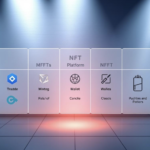Now Reading: Develop an AI Crypto Trading Algorithm: A Comprehensive Guide
- 01
Develop an AI Crypto Trading Algorithm: A Comprehensive Guide
Develop an AI Crypto Trading Algorithm: A Comprehensive Guide

In today’s fast-paced financial markets, speed and accuracy are critical for success. The integration of advanced technologies has transformed how decisions are made, particularly in the world of digital assets. By leveraging sophisticated systems, traders can process millions of data points in seconds, ensuring optimal performance across multiple platforms.
Quantitative strategies play a significant role in modern markets, offering real-time processing and adaptability. These systems operate 24/7, eliminating emotional biases and ensuring consistent execution. For example, platforms like Modulus Global handle high-frequency operations seamlessly, providing a competitive edge in volatile environments.
With over 60% of U.S. equity trades relying on automated systems, the benefits are clear. These tools not only enhance efficiency but also continuously optimize through machine learning. This approach ensures that strategies evolve with market conditions, delivering long-term success. To learn more about building such systems, check out this detailed guide.
Understanding AI Crypto Trading Algorithms
Modern financial markets demand tools that can keep up with rapid changes. Automated systems, like trading bots, have become essential for processing vast amounts of market data efficiently. These tools eliminate human limitations, such as reaction time and emotional bias, ensuring consistent performance.
What is an AI Crypto Trading Algorithm?
An algorithm is a set of rules designed to analyze data and make decisions. In trading, these rules are powered by machine learning, enabling them to recognize patterns in historical charts, social signals, and other sources. This multi-data approach allows for more accurate predictions and faster execution of trades.
Why Use AI in Crypto Trading?
One of the biggest advantages is speed. Automated systems can process information and execute trades in milliseconds, far outpacing human capabilities. They also operate 24/7, monitoring multiple crypto pairs and exchanges simultaneously. This scalability ensures that opportunities are never missed.
For example, platforms like Modulus Global use advanced systems to manage risk and optimize strategies. Their tools have generated significant profits, such as a $1.3M case from arbitrage strategies. By integrating APIs with major exchanges like Binance, these systems ensure seamless operation and real-time data analysis.
Key Components of an AI Crypto Trading Algorithm
Effective strategies in digital finance rely on three core components working seamlessly together. These elements ensure that the system operates efficiently, adapts to changes, and minimizes risks. Let’s explore each component in detail.
Data Collection and Analysis
Accurate market data is the backbone of any successful strategy. Systems require clean historical data, ideally spanning three or more years, to identify meaningful patterns. This includes OHLCV (Open, High, Low, Close, Volume) metrics and on-chain indicators.
Feature engineering plays a crucial role in transforming raw data into actionable insights. By selecting relevant variables, the system can predict trends more effectively. A well-structured API data pipeline ensures real-time updates and seamless integration with exchanges.
Machine Learning Models
Advanced models like LSTM networks are ideal for time-series prediction. These frameworks, such as TensorFlow and PyTorch, enable the system to learn from historical data and adapt to new market conditions. Reinforcement learning is particularly effective for dynamic adjustments.
Supervised and unsupervised learning approaches each have their strengths. While supervised models rely on labeled data, unsupervised methods can uncover hidden patterns. GPU acceleration further enhances training speed, ensuring the system remains responsive.
Risk Management Systems
Protecting investments is critical in volatile markets. Effective systems include position sizing rules, limiting exposure to 1-3% per trade. Volatility-adjusted stop-loss mechanisms and slippage protection further safeguard against unexpected fluctuations.
Backtesting with at least 3,000 data points ensures the strategy’s reliability. By simulating trading strategies on historical data, traders can refine their approach and improve execution accuracy. These protocols build confidence in the system’s performance.
Steps to Develop an AI Crypto Trading Algorithm
Building a robust system for digital finance requires a structured approach. Start by defining clear objectives and selecting the right tools. Then, focus on preparing and cleaning your data for optimal performance. This process ensures your system can adapt to changing market conditions and deliver consistent results.
Define Your Trading Objectives
Begin by outlining your goals using the SMART framework. This means your objectives should be Specific, Measurable, Achievable, Relevant, and Time-bound. For example, a goal could be to achieve a 10% monthly return using a trading bot.
Clear objectives help you choose the right strategies and measure success. They also guide the development process, ensuring your system aligns with your financial goals.
Choose the Right Technology Stack
Selecting the right tools is crucial for efficiency. Python is the preferred language for 78% of projects due to its simplicity and extensive libraries. For high-frequency systems, C++ offers faster execution speeds.
Deployment options include cloud platforms like AWS EC2 for scalability. Local setups are ideal for testing, while cloud solutions handle real-time operations. Consider the tradeoffs to match your needs.
Data Preparation and Cleaning
Accurate historical data is the foundation of any successful system. Start by normalizing your data using techniques like Z-score or min-max scaling. This ensures consistency across different datasets.
Missing data can skew results, so use imputation methods like mean or median replacement. Also, normalize time zones to avoid discrepancies in multi-exchange systems.
APIs like Binance have rate limits, such as 600 requests per minute. Plan your data collection to stay within these limits. For storage, consider solutions like AWS S3 or Snowflake for scalability.

Finally, implement CI/CD pipelines for seamless updates. This ensures your system evolves with market changes, maintaining peak performance.
Building the Algorithm: A Step-by-Step Guide
Creating a reliable system for financial markets involves careful planning and execution. Each step must be meticulously designed to ensure accuracy and efficiency. This guide walks you through selecting the right tools, training your system, and validating its performance.
Selecting the Right Machine Learning Model
Choosing the appropriate models is crucial for success. Different frameworks excel in various tasks. For example, XGBoost achieves 68% accuracy in price prediction, making it a strong candidate for price forecasting.
Compare options like ARIMA, Prophet, and LSTM to find the best fit for your strategies. ARIMA is ideal for linear data, while LSTM handles complex, non-linear patterns effectively. Use tools like Optuna for hyperparameter tuning to optimize performance.
Training the Model with Historical Data
Accurate historical data is the foundation of any successful system. Use a 70/30 train/test split to ensure your model generalizes well to new data. Walk-forward validation prevents overfitting, ensuring the system adapts to changing conditions.
Feature engineering transforms raw data into actionable insights. Select relevant variables to improve prediction accuracy. Clean and normalize your data to avoid discrepancies and ensure consistency.
Backtesting Your Algorithm
Backtesting validates your system’s performance using historical data. Incorporate transaction costs and slippage simulations to ensure realistic results. A case study on TQQQ demonstrates the importance of these adjustments.
Use Sharpe ratio optimization to balance risk and reward. Monte Carlo stress testing evaluates the system’s resilience under extreme conditions. Version control ensures you can track and improve your models over time.
PnL attribution analysis helps identify the sources of profit and loss. This step ensures your system delivers consistent results and meets your financial goals.
AI Crypto Trading Algorithm Development Guide: Tools and Platforms
The right tools and platforms are essential for building efficient financial systems. Whether you’re developing a custom solution or leveraging existing frameworks, choosing the right technology can make all the difference. This section explores popular options and key resources to streamline your workflow.
Popular AI Development Platforms
Several platforms stand out for their robust features and scalability. Modulus Global, for instance, offers customizable high-frequency systems tailored to specific needs. AWS EC2 t3.xlarge instances are another excellent choice, capable of handling over 100 concurrent strategies with ease.
For testing, the Alpaca Paper API provides a risk-free environment to validate your trading bots. Comparing AWS and Google Cloud ML offerings can help you decide which platform aligns best with your goals. Each option has unique strengths, so consider factors like cost, scalability, and ease of integration.
Essential Tools for Algorithm Development
QuantConnect is a powerful tool for backtesting, allowing you to simulate strategies using historical data. Docker containerization simplifies deployment, ensuring consistency across environments. When it comes to coding, JupyterLab and VS Code are popular choices, each with distinct advantages for developers.
APIs like Coinbase Pro and CCXT facilitate seamless integration with multiple exchanges. MLflow is invaluable for experiment tracking, while Prometheus and Grafana offer robust monitoring capabilities. For data analysis, NumPy and Pandas provide efficient optimization techniques, enhancing your system’s performance.
Understanding the differences between WebSocket and REST APIs can also improve execution speed. By leveraging these tools, you can build a reliable and scalable system tailored to your needs.
Implementing Trading Strategies with AI
Success in financial markets often hinges on the ability to adapt quickly to changing conditions. Automated systems excel in this area, offering precise execution and real-time analysis. By leveraging advanced tools, traders can implement strategies that capitalize on market conditions and deliver consistent results.

Arbitrage Strategies
Arbitrage involves exploiting price differences across markets. Triangular arbitrage, for example, can yield 0.15-0.3% per trade. Key steps include:
- Statistical arbitrage pair selection: Identify correlated assets using historical data.
- Kalman filter cointegration models: Ensure accurate price alignment for execution.
- ATR-based position sizing: Adjust trade sizes based on volatility to manage risk.
These methods ensure opportunities are seized quickly and efficiently.
Trend Following Strategies
Trend following focuses on identifying and capitalizing on market momentum. MACD crossover strategies, for instance, achieve a 54% win rate. Key considerations include:
- SMA vs EMA trend identification: Use moving averages to detect patterns early.
- Order book imbalance detection: Spot signals indicating potential price movements.
- BitMEX liquidations data usage: Leverage liquidation events to predict trends.
These techniques help traders stay ahead of the curve.
Market Making Strategies
Market making involves providing liquidity by placing buy and sell orders. This requires
- TWAP execution algorithms: Ensure smooth order placement over time.
- Adverse selection protection: Minimize losses from unfavorable trades.
- Inventory risk management: Balance exposure to maintain stability.
By focusing on speed and precision, market makers can thrive in volatile environments.
For more insights into advanced trading strategies, check out this detailed resource.
Deploying Your AI Crypto Trading Algorithm
Deploying a trading bot requires careful planning and execution to ensure seamless operation. From selecting the right exchange to integrating APIs and monitoring performance, each step plays a crucial role in achieving success. This section covers the essential aspects of deploying your system effectively.
Choosing the Right Exchange
Selecting the right exchange is the foundation of your deployment strategy. Factors like liquidity, fee structures, and security protocols must be evaluated. For example, Binance handles over $76B in daily volume, making it a popular choice for high-frequency operations.
Compare exchange liquidity profiles to ensure your trading bot can execute trades efficiently. Analyze fee structures to minimize costs and maximize profitability. Additionally, consider cold wallet integration for enhanced security.
API Integration
API integration is critical for connecting your bot to exchanges. Libraries like CCXT support over 120 exchanges, simplifying the process. Ensure proper implementation of protocols like FIX and WebSocket for real-time data access.
Use HMAC authentication to secure your APIs and monitor rate limits to avoid disruptions. Implementing circuit breakers can also protect your system during volatile market conditions.
Real-Time Monitoring
Real-time monitoring ensures your system operates smoothly. Tools like CloudWatch track over 50 performance metrics, providing valuable insights. Set up PagerDuty alerts to notify you of any issues immediately.
Automate your trading journal to track performance and identify areas for improvement. By continuously monitoring your system, you can ensure optimal execution and adapt to changing market conditions.
Optimizing and Scaling Your Algorithm
To stay ahead in dynamic markets, optimizing and scaling your system is essential. This ensures your trading bots adapt to changing market conditions and deliver consistent performance. Let’s explore how to achieve this effectively.
Continuous Learning and Model Updates
Markets evolve, and so should your models. Concept drift detection identifies when patterns change, ensuring your system remains accurate. Rolling window retraining updates your models with the latest data, maintaining relevance.
Batch vs. online learning offers different advantages. Online learning, for instance, achieves a 23% accuracy boost by adapting in real-time. This approach ensures your strategies stay effective as conditions shift.
Scaling for Multiple Cryptocurrencies
Handling multiple assets requires robust systems. Asset correlation matrices help identify relationships between cryptocurrencies, optimizing portfolio construction. Eigenportfolio techniques further enhance diversification and risk management.
Memory optimization and distributed computing setups, like Kubernetes, manage 1000+ parallel instances efficiently. Redis handles over 1M transactions per second, ensuring low latency and high performance.
Exchange-specific adapters streamline integration, while latency reduction strategies improve execution speed. These steps ensure your technology scales seamlessly across diverse assets and platforms.
Challenges in AI Crypto Trading Algorithm Development
Developing automated financial systems comes with its own set of challenges that require careful navigation. From unpredictable market conditions to stringent regulatory requirements, these hurdles can impact the execution and success of your strategies. Understanding these challenges is crucial for building resilient and efficient systems.
Market Volatility
One of the most significant challenges is market volatility. For instance, Bitcoin’s 30-day volatility averages 3.8%, making it a highly unpredictable asset. Fat tail events, such as sudden price crashes or spikes, can disrupt even the most robust trading strategies.
To mitigate these risks, consider analyzing historical data for extreme events. Implement stop-loss mechanisms and diversify your portfolio to reduce exposure. These steps can help you navigate the unpredictable nature of digital assets.
Data Security Concerns
Data security is another critical issue. With the rise of cyber threats, protecting sensitive information is paramount. Multi-signature wallets, for example, prevent 98% of hacks by requiring multiple approvals for transactions.

Cybersecurity best practices include regular audits, encryption, and disaster recovery plans. Ensuring your systems are secure not only protects your assets but also builds trust with users.
Regulatory Compliance
Navigating regulatory requirements is essential for long-term success. The SEC, for instance, mandates certification for certain trading algorithms. Additionally, GDPR compliance ensures data privacy for users in the European Union.
KYC (Know Your Customer) and AML (Anti-Money Laundering) integration are also crucial. These measures help prevent illegal activities and ensure your systems operate within legal boundaries. Jurisdiction analysis can further clarify the rules applicable to your operations.
By addressing these challenges, you can build a more resilient and compliant trading system. Staying informed and proactive is key to overcoming these hurdles.
Case Studies: Successful AI Crypto Trading Algorithms
Exploring real-world examples can provide valuable insights into effective financial systems. These case studies highlight the benefits of using advanced tools and strategies to achieve consistent performance. By analyzing these examples, you can better understand how to optimize your own systems.
Modulus Global AI
Modulus Global is a standout example of a high-frequency trading bot that delivers impressive results. Its architecture is designed for speed and precision, achieving 23% annualized returns. The system’s ability to process vast amounts of data in real-time ensures optimal performance in volatile markets.
Key features include advanced risk management protocols and seamless integration with major exchanges. These elements make Modulus a reliable choice for traders seeking consistent results.
Other Notable Examples
Several other platforms have also demonstrated success in the financial sector:
- 3Commas: With over 500,000 users, this platform offers a smart portfolio feature that automates asset allocation.
- Quadency: Handling more than $10 billion in volume, Quadency provides a user-friendly interface for managing multiple exchanges.
- HaasOnline: Known for its visual editor, this tool allows users to create custom trading bots without coding.
- Cryptohopper: This platform excels in social trading, enabling users to replicate successful strategies.
- ArbitrageScanner: With a 94% uptime, this tool identifies arbitrage opportunities across exchanges.
- Shrimpy: Focused on portfolio rebalancing, Shrimpy ensures optimal asset distribution.
- Coinrule: Its template system simplifies the creation of automated trading rules.
- Gunbot: Offers extensive configuration options for advanced users.
- Bitsgap: Specializes in grid trading, a strategy that capitalizes on price fluctuations.
- Mudrex: Features a strategy marketplace where users can buy and sell proven strategies.
These examples showcase the diverse applications of intelligence in financial systems. By leveraging these tools, traders can enhance their performance and achieve their financial goals.
Future Trends in AI Crypto Trading
The financial landscape is evolving rapidly, driven by cutting-edge innovations that reshape how we approach digital assets. As technology advances, new opportunities emerge for traders to optimize their strategies and stay ahead of the curve.
Integration of Blockchain and Advanced Systems
One of the most exciting developments is the integration of blockchain with advanced systems. Zero-knowledge proofs (ZK-proofs) now verify over 1 million transactions per second, enhancing security and efficiency. This innovation is particularly useful in decentralized finance (DeFi) protocols, where transparency and speed are critical.
Cross-chain arbitrage is another area gaining traction. By leveraging multiple blockchains, traders can exploit price differences across platforms. This approach requires robust models to analyze and execute trades seamlessly.
Advancements in Machine Learning
Machine learning continues to push boundaries in trading. Federated learning, for instance, enables 45% faster updates to models, ensuring they adapt to changing market conditions. Transformers are also being used to process news sentiment, providing valuable insights for decision-making.
Other notable advancements include:
- Reinforcement learning: Improves dynamic strategy adjustments.
- Synthetic data generation: Enhances training datasets for better predictions.
- Explainable AI: Ensures transparency in decision-making processes.
These trends highlight the growing role of technology in shaping the future of trading. By staying informed and adopting these innovations, traders can unlock new levels of efficiency and profitability.
Taking Your Crypto Trading to the Next Level with AI
To elevate your financial strategies, leveraging advanced tools can make a significant difference. Top performers achieve over 300% annual returns by mastering risk management and diversifying their approaches. Continuous learning is key to staying ahead in this dynamic field.
Consider pursuing professional certifications to deepen your expertise. Community resources and forums can also provide valuable insights and support. Hardware acceleration, such as GPUs, can enhance processing speeds for better performance.
Benchmarking your results ensures your strategies remain effective. Security audits and tax optimization are essential for safeguarding your investments. By adopting these practices, you can create a robust roadmap for long-term success.
FAQ
What is an AI Crypto Trading Algorithm?
An AI crypto trading algorithm is a system that uses machine learning and data analysis to automate buying and selling decisions in the cryptocurrency market. It processes real-time data to execute trades based on predefined strategies.
Why should I use AI in crypto trading?
AI enhances trading by analyzing vast amounts of data quickly, identifying patterns, and executing trades with precision. It reduces human error and operates 24/7, making it ideal for volatile markets.
What are the key components of an AI crypto trading algorithm?
The main components include data collection and analysis, machine learning models, and risk management systems. These work together to ensure accurate predictions and minimize losses.
How do I define my trading objectives?
Start by identifying your goals, such as profit targets, risk tolerance, and preferred cryptocurrencies. Clear objectives help shape the algorithm’s design and strategy.
What tools are essential for developing a trading algorithm?
Popular tools include Python, TensorFlow, and platforms like Binance API. These help in data analysis, model training, and integrating with exchanges for real-time execution.
How do I backtest my algorithm?
Backtesting involves running your algorithm on historical data to evaluate its performance. This helps identify strengths and weaknesses before deploying it in live markets.
What are arbitrage strategies in crypto trading?
Arbitrage strategies involve buying a cryptocurrency on one exchange at a lower price and selling it on another at a higher price. AI can quickly identify and exploit these opportunities.
How do I choose the right exchange for my algorithm?
Consider factors like liquidity, fees, and API reliability. Popular exchanges like Binance and Coinbase offer robust APIs for seamless integration.
What challenges might I face in developing an AI trading algorithm?
Challenges include market volatility, ensuring data security, and complying with regulations. These require careful planning and continuous monitoring.
What are the future trends in AI crypto trading?
Trends include deeper integration of AI with blockchain technology and advancements in machine learning models, which will further enhance trading efficiency and accuracy.















